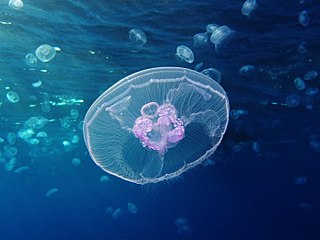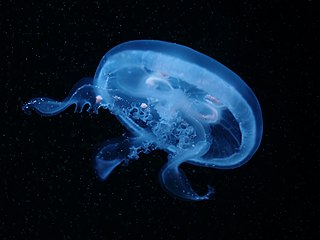
Aurelia aurita is a species of the genus Aurelia. All species in the genus are very similar, and it is difficult to identify Aurelia medusae without genetic sampling; most of what follows applies equally to all species of the genus. The most common method used to identify the species consists of selecting a jellyfish from a harbour using a device, usually a drinking glass and then photographing the subject. This means that they can be released in to the harbour shortly afterwards and return to their natural habitat.

The lion's mane jellyfish, also known as the giant jellyfish, arctic red jellyfish, or the hair jelly, is one of the largest known species of jellyfish. Its range is confined to cold, boreal waters of the Arctic, northern Atlantic, and northern Pacific Oceans. It is common in the English Channel, Irish Sea, North Sea, and in western Scandinavian waters south to Kattegat and Øresund. It may also drift into the southwestern part of the Baltic Sea. Similar jellyfish – which may be the same species – are known to inhabit seas near Australia and New Zealand. The largest recorded specimen was measured off the coast of Massachusetts in 1865 and had a bell with a diameter of 210 centimetres and tentacles around 36.6 m (120 ft) long. Lion's mane jellyfish have been observed below 42°N latitude for some time in the larger bays of the East Coast of the United States.

Cassiopea is a genus of true jellyfish and the only members of the family Cassiopeidae. They are found in warmer coastal regions around the world, including shallow mangrove swamps, mudflats, canals, and turtle grass flats in Florida, and the Caribbean and Micronesia. The medusa usually lives upside-down on the bottom, which has earned them the common name. These jellyfish partake in a symbiotic relationship with photosynthetic dinoflagellates and therefore, must lie upside-down in areas with sufficient light penetration to fuel their energy source. Where found, there may be numerous individuals with varying shades of white, blue, green and brown.

Aurelia is a genus of scyphozoan jellyfish, commonly called moon jellies. There are currently 25 accepted species and many that are still not formally described.
A species description is a formal scientific description of a newly encountered species, usually in the form of a scientific paper. Its purpose is to give a clear description of a new species of organism and explain how it differs from species that have been described previously or are related. To be considered valid, a species description must follow guidelines established over time. Naming requires adherence to respective codes, for example: in zoology, the International Code of Zoological Nomenclature (ICZN); plants, the International Code of Nomenclature for algae, fungi, and plants (ICN); viruses, the International Committee on Taxonomy of Viruses (ICTV). The species description often contains photographs or other illustrations of type material along with a note on where they are deposited. The publication in which the species is described gives the new species a formal scientific name. Some 1.9 million species have been identified and described, out of some 8.7 million that may actually exist. Millions more have become extinct throughout the existence of life on Earth.

Nausithoe aurea, also known as the Nausithoe maculata, is a species of crown jellyfish found off the southeastern coast of Brazil. The central disc has been measured to be 10.5 mm. N. aurea is transparent with yellow and brown spots located around the gonads. N. aurea can reproduce either asexually by strobilation or sexually. Either ephyrae or planuloids may be produced by strobilation; only ephyrae can produce the medusal form. Strobilation can be induced to occur when food is abundant. In polyps, a large availability of food leads to strobilation if it is not regulated. N. aurea species usually take more than 20 weeks to begin the differentiation and development of reproductive organs.

Aurelia labiata is a species of moon jellyfish. It is a cnidarian in the family Ulmaridae. It is typically larger than Aurelia aurita, with individuals document up to 45 cm (18 in). However, much of its size range overlaps with A. aurita, making size an imperfect diagnostic tool. Most Aurelia labiata have a 16-scalloped bell, meaning the bell indents inward at 16 points, a characteristic that also appears in other Aurelia species. Aurelia labiata occurs in the northeastern Pacific Ocean, from the northern coast of California, north to Canada and into Alaska.

Lipkea is a genus of stalked jellyfish. It is the only genus in the monotypic family Lipkeidae. Lipkea species lack tentacles at the end of their bell.

Diadumene is a genus of sea anemones. It is the only genus in the monotypic family Diadumenidae.

Chrysaora helvola is a jellyfish in the family Pelagiidae. Although still recognized as a valid species by the World Register of Marine Species, its taxonomic history is confusing and recent reviews of the genus have not recognized it.

Chrysaora chinensis, or the Indonesian sea nettle, is a species of jellyfish in the family Pelagiidae. It is native to the central Indo-Pacific region and its sting is considered dangerous.
Chrysaora lactea is a sea nettle in the family Pelagiidae. This jellyfish has a bell diameter of up to 25 cm (10 in), and it is native to the Atlantic coast of South America. It has also been reported from the Caribbean region, but genetic studies indicate that this population is closer to C. chesapeakei. A comprehensive taxonomic review is necessary to resolve this matter.

The South American sea nettle is a species of jellyfish from the family Pelagiidae. It is found from the Pacific coast of Peru, south along Chile's coast to Tierra del Fuego, and north along the Atlantic coast of Argentina, with a few records from Uruguay. Despite its common name, it is not the only sea nettle in South America. For example, C. lactea is another type of sea nettle in this region. Historically, C. plocamia was often confused with C. hysoscella, a species now known to be restricted to the northeast Atlantic. C. plocamia is a large jellyfish, up to 1 m in bell diameter, although most mature individuals only are 25–40 cm (10–16 in).

Cassiopea ornata are one of many Cnidarian species called the upside-down jellyfish. This pelagic jellyfish primarily lives in tropical waters, off the coast of Australia in shallow lagoons and around mangrove trees. The name "upside-down jellyfish" comes from the fact that it appears to be upside-down in its natural state—resting on its bell. Its bell is a golden/brown color and the tentacles vary with different shades of yellow. While the sighting of this particular species is rare, it is usually mistaken for vegetation like the other species in genus Cassiopea.

Tamoya haplonema is a species of box jellyfish in the genus Tamoya. It is the type species of the genus and was described in 1859. The medusa possesses four tentacles, one each on an inter-radial pedal.

Aurelia marginalis is a species of the genus Aurelia. All species in the genus are very similar, and it is difficult to identify Aurelia medusae without genetic sampling.
Netrostoma setouchianum is a species of true jellyfish in the family Cepheidae. It has been found in the Pacific Ocean off the coasts of Japan, China and Vietnam.
Aurelia ayla is a species of true jellyfish in the family Ulmaridae. It is known via type specimens found in waters off the coast of Bonaire.
Aurelia cebimarensis is a species of true jellyfish in the family Ulmaridae. It is known via type specimens found in waters off the coast of Brazil.
Aurelia insularia is a species of true jellyfish in the family Ulmaridae. It is known via polyp type specimens found in waters off the coast of Brazil, around Ilha Grande.












